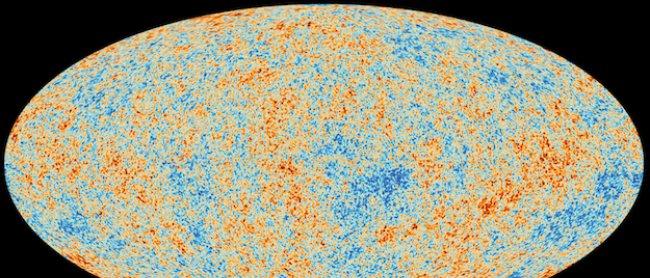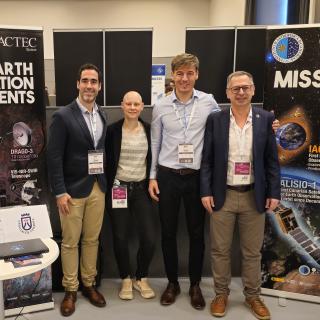The most recent data from the Planck satellite of the European Space Agency (ESA) confirm, with a fair degree of probability, the standard cosmological model currently used to describe the formation and evolution of the universe. The results, which have just been presented, ratify with greater precision than in the previous publications (in 2013 and 2015) the temperature and the polarization of the radiation known as the cosmic microwave background (CMB), a fossil of the radiation generated during the initial phases of the universe, and whose characteristics give us valuable information about the age, the rate of expansion, the history, and the energy content of the cosmos.
According to Jan Tauber, project scientist of the Planck project of ESA “Up till now, the standard model of cosmology has passed all the tests, and Planck as made the measurements which show this”. Reno Mandolesi, Principal Investigator of the Low Frequency Instrument (LFI) on the Planck satellite, from the University of Ferrara (Italy) considers that the rigour achieved in the data processing should put an end to the previous caution about their validity, and says that “now we are sure that we can obtain a cosmological model based only on temperature, only on the polarization, or one based on both the temperature and the polarization, and all of them agree.
These final results, which have been called the “Planck Legacy”, confirm to cosmologists their present description of the universe as containing ordinary matter, cold dark matter, and dark energy, and comprising structures which originated in a brief initial phase of its expansion, termed “inflation”. However, even though the mission has reinforced the models used by researchers, there are still a number of questions to resolve.
For Jose Alberto Rubiño, a researcher at the Instituto de Astrofísica de Canarias (IAC) and a member of the Planck consortium, “The Planck Legacy verifies, the standard cosmological model with unprecedented precision, although this model is not complete, because primordial gravitational waves, predicted by inflation, have not yet been detected, and he adds “The Planck maps are an exceptional guide in our search for the primordial signal associated with the first fraction of a second of the life of the observable universe”.
New Physics
Another question which still needs an explanation is related to the expansion of the universe, whose rate is given by the Hubble Constant. To measure this value, which measures the rate at which the expansion velocity of the universe varies with the distance, there are two methods which can be used. One is traditional, using the local universe and measuring the apparent luminosity of certain types of nearby variable stars, and exploding stars whose luminosities are known (the so-called “standard candles”), and the other is based on the early, distant universe, using the cosmological model which bets fits the measurements of the cosmic microwave background.
Although these two very different ways to measure the Hubble constant give quite similar results, those working on each of them are convinced that the uncertainties in their respective methods are not big enough to explain the difference. For this reason many of them think that we may need “new physics”.
This physics would be related to the detection of exotic particles or forces which could be affecting the results. In spite of this, the Planck results put strong restrictions on this line of thought, because the majority of the observations are mutually consistent and consistent with the current models. “For the time being we should not get too excited about finding “new physics”; it is possible that the relatively modest discrepancy can be explained by a combination of small errors and local effects. But we need to continue to improve our measurements, and thinking of new ways to explain them” thinks Tauber.
A history of caution
Planck was launched in 2009 and gathered data until 2013. Its first publication which appeared in the latter year was based only on the temperature of the microwave background radiation, and used only the first two maps of the sky from the mission. Its “image” of the cosmos, although similar to that obtained by the two previous NASA missions, CÖBE and WMAP, showed for the first time the imprint of the early universe with unprecedented accuracy and sharpness.
Those data also gave evidence for inflation, showing the relative distribution of the small primordial fluctuations which were the seeds of all known cosmic structures. In addition Planck measured the polarization of the background radiation, how this vibrates in a preferential direction, and which carries traces of the last interaction between this radiation and the matter in the early universe, and so contains information about the first instants of the observable universe.
In 2015, a second publication collected together all the data obtained during the mission, using eight maps of the sky. Planck then gave information about the temperature and the polarization, but with one problem: the quality of some of the polarization data was not sufficiently good, and some of the conclusions needed confirming. This caution has finally given way to the evidence of the newly processed data in 2018, which have just been published.
The Planck mission included, from its initial phases, researchers from the IAC and its Instrumentation Division, where a team led by Professor Rafael Rebolo (a co-Investigator on this space mission) developed, between 1993 and 2008 the electronics for the control of the low frequency instrument (LFI) the software for controlling the instrument, and the software for the data compression. In addition, from the IAC Jose Alberto Rubiño has coordinated one of the seven principal scientific groups of the Planck mission (the “Galaxy Clusters” group). And among other aspects, the cosmology group of the IAC has contributed to the processing and validation of the maps of the LFI, as members of the “LFI Core Team”.
Interesting links:
https://www.cosmos.esa.int/web/planck/publications
Video about Plank legacy (ESA/Planck Collaboration)
Other press release:
La misión espacial Planck recibe el premio Gruber de Cosmología
Contact:
- José Alberto Rubiño Martín, investigador del IAC: jalberto [at] iac.es (jalberto[at]iac[dot]es)
- Beatriz Ruiz Granados, investigadora del IAC: bearg [at] iac.es (bearg[at]iac[dot]es)



